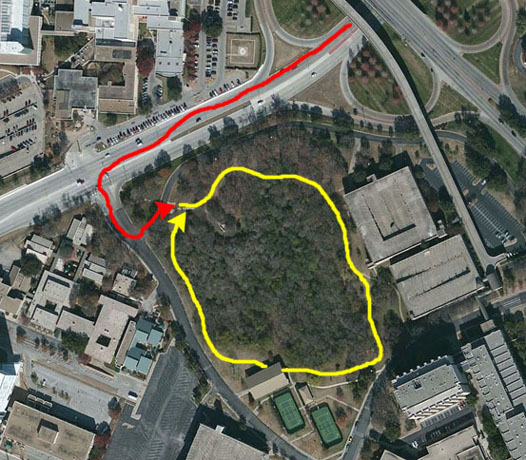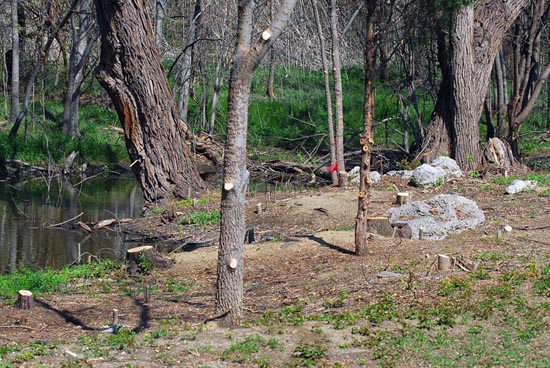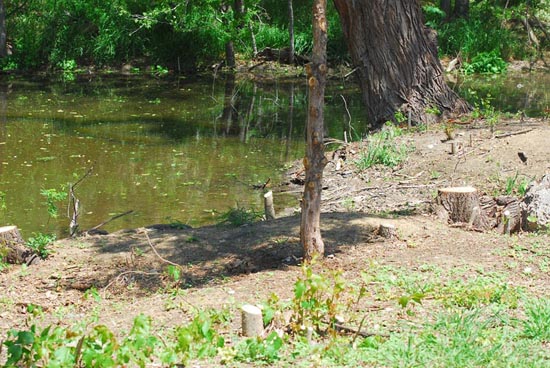


 |
July 19, 2015: The Bernie Sanders Rally in Dallas |
 |
July 3-7, 2015: 4th of July at Ruckman Haus |
 |
Return to the Index for 2015 |
|
As it turns out, they told us, this multi-acre area is an official bird nesting area and is, apparently, protected from any further development associated with the huge Parkland complex right next door. Al and Kathy had been here before, and they were happy to show us around.
But it wasn't until today that Fred and I returned with our cameras and with our friends Steve and Mario. Though the day was very, very warm, we enjoyed our walk around the nesting area.
The Bird Sanctuary at Parkland Hospital
|
 |
Although we won't start off on our walk around the nesting area until we look at a bit of history, I've marked the route we took as we walked around the area on this hot, humid afternoon.
|
Even so, by the outbreak of the war, there were over 250,000 people in the city, and city services were everywhere being stretched. One area where improvement was needed was the public hospital system, and just after the war plans were made for a large new hospital complex to be built about two miles west of downtown, in a residential/rural area at the intersection of two of the west side's major streets.
There wasn't much around the 150-acre area; the unoccupied Trinity River basin lay to the south, while two miles up Inwood Road some of Dallas' newest (and nicest) homes were being constructed- the very beginnings of the 50-year push north of residential housing.
The photo at left comes from the library archives of UT-Southwestern. It was taken sometime in the late 1940s or early 1950s. Note that I-35 doesn't exist yet, nor does the cloverleaf at the intersection of Harry Hines and Inwood. In fact, there's really not much of anything developed between Inwood and downtown Dallas at that time.
But the Dallas Hospital District did indeed purchase the land for Parkland, and construction began on the first of its buildings right around 1950.
|
The construction of the Interstate Highway system in the 1950s has resulted in the appearance by this time of I-35, which came up from south central Texas, passed through Dallas and headed on up to Oklahoma. (It was not yet called "I-35E" because while it had become apparent that I-35 should split somewhere south of the Metroplex, with one branch going through Fort Worth and one through Dallas, the western branch had just officially opened, and signage still needed to be changed. In fact, billboards existed along I-35 south of the area up until the 1970s, telling drivers heading from Texas to Oklahoma that it would be faster to take the new, I-35W route.)
The cloverleaf at Harry Hines and Inwood dates to the early 1960s, another clue to the age of the photo. The buildings near the top are Parkland Hospital and early SWMC buildings. As far as the rookery is concerned, you can see the treed area where it would eventually be established in the photo at right. Parkland is still expanding, though, and for the next thirty years it would build more and more buildings moving towards Inwood Road. Other construction in the area was spurred by the development of Parkland and UT-Southwestern, but by the turn of the century ornithologists had convinced the Hospital board to direct any further development south towards I-35E, and the rookery came to be thought of as a set-aside.
Our Visit to the Rookery
 |
 |
We saw quite a few birds on our walk around, but only a few different kinds. The most common was the Great Egret.
|
 |
The great egret is a large heron with all-white plumage. Standing up to 3.3 feet tall, this species can measure 40 in. in length and have a wingspan of 67 in. Average weight is just over two pounds, though they can weigh more than three. Apart from being slightly smaller than other white egrets, this egret can be distinguished by its yellow bill and black legs and feet, though the bill may become darker and the lower legs lighter in the breeding season. In breeding plumage, delicate ornamental feathers are borne on the back. Males and females are identical in appearance; juveniles look like non-breeding adults.
It has a slow flight, with its neck retracted. This is characteristic of herons and bitterns, and distinguishes them from storks, cranes, ibises, and spoonbills, which extend their necks in flight. The great egret is not normally a vocal bird; it gives a low hoarse croak when disturbed, and at breeding colonies, it often gives a loud croaking cuk cuk cuk and higher-pitched squawks. We can definitely attest to the squawkiness of these birds.
These bird were very common here (and Fred and I have seen them near water all over the Metroplex), and we took quite a few pictures of them. Even after eliminating the bad ones, I was left with quite a few good enough to include here. Here are clickable thumbnails for more of them:
 |
Another bird we saw some examples of was the little blue heron, which breeds in the Gulf states of the US, through Central America and the Caribbean south to Peru and Uruguay. It is a resident breeder in most of its range, but some northern breeders migrate to the southeastern US or beyond in winter. There is post-breeding dispersal to well north of the nesting range, as far as the Canada–US border.
|
Here are clickable thumbnails for some more of the pictures we took today of the Little Blue Heron:
 |
The legs and feet are dark blue and the sexes are similar. Non-breeding adults have dark blue head and neck plumage and paler legs. Young birds are all white except for dark wing tips and have dull greenish legs. They gradually acquire blue plumage as they mature.
Fred also got a really nice shot of a little blue heron and its two young, high up in a nest in one of the trees towards the center of the nesting area. Some branches and the distance marred the zoom shot somewhat, but it is still a good one and you can see it here.
We saw one other common heron here at the nesting area- the black-crowned night heron. This medium-sized heron is found throughout a large part of the world, except in the coldest regions and Australasia. In the southern United States, it is ubiquitous- except for a few regional areas where its population has inexplicably declined. One of those regions is the Gulf Coast of Texas, although we certainly saw a large number of these birds, both juveniles and adults, here in the nesting area.
|
 |
Immature birds have dull grey-brown plumage on their heads, wings, and backs, with numerous pale spots. Their underparts are paler and streaked with brown. The young birds have orange eyes and duller yellowish-green legs. They are very noisy birds in their nesting colonies, with calls that are commonly transcribed as "quok" or "woc". Click on the thumbnails below for some other pictures of the juveniles that we saw:
 |
Their breeding habitat is fresh and salt-water wetlands throughout much of the world. Black-crowned night herons nest in colonies on platforms of sticks in a group of trees, or on the ground in protected locations such as islands or reedbeds. Three to eight eggs are laid. This heron is migratory in the northernmost part of its range, but otherwise resident (even in the cold Patagonia). The North American population winters in Mexico, the southern United States, Central America, and the West Indies, and the Old World birds winter in tropical Africa and southern Asia.
These birds stand still at the water's edge and wait to ambush prey, mainly at night or early morning. They primarily eat small fish, crustaceans, frogs, aquatic insects, small mammals, and small birds. During the day they rest in trees or bushes. This was the first time I recall seeing this particular kind of heron.
Although it was hot today, the tall trees provided some respite from the bright sun as we walked in a circular path around the central nesting area. Fred took most of the bird pictures with his zoom, while I took more expansive shots as we walked along. Click on the thumbnails below to see some of these pictures:
 |
We really enjoyed walking around this area, which certainly qualifies as a gem right in the heart of the city.
You can use the links below to continue to another photo album page.
 |
July 19, 2015: The Bernie Sanders Rally in Dallas |
 |
July 3-7, 2015: 4th of July at Ruckman Haus |
 |
Return to the Index for 2015 |